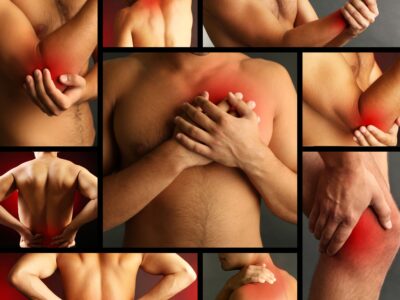Overcoming neck, back, and hip pain naturally
Five years ago my husband said, “You’re walking funny. You don’t swing your right arm.” Every time we walked together, he was always reminding me to do this. I also noticed that, due to a low grade pain in my right hip, I twisted my body while I walked. Thinking I’d slept wrong or needed a new mattress, I ignored the pain for a long time. Then I noticed I couldn’t lift my right arm easily. That’s when I searched for someone who could reduce or eliminate these problems without using pharmaceuticals. I found Christina Wilson, certified neuromuscular therapist who specializes in trigger point therapy. Within months, most of my pain disappeared and my movements returned to normal. She taught me how to get rid of the pain at home.
What are trigger points?
Drs. Travell and Simon describe them as “a hyper irritable spot in skeletal muscle that is associated with a hypersensitive palpable nodule in a taut band. This spot is painful on compression and can give rise to characteristic referred pain, referred tenderness, motor dysfunction, and autonomic phenomena.” Translated, this means trigger points are angry little spots in tight bands of muscle tissue that hurt when you press on them.
Christina, why did you become a trigger point therapist?
 In 1989, I ruptured two discs in my neck between C5 & 6 and C6 & 7. After two years of chiropractic care and the second MRI, it was clear that I had to have a triple fusion. In 1991, I had the first surgery, but the discs did not fuse correctly. So in 1993, I had the second surgery, which was successful as far as the fusion was concerned. However, I was in pain and on pharmaceuticals since the beginning of the injury and continually after that until 2004.
In 1989, I ruptured two discs in my neck between C5 & 6 and C6 & 7. After two years of chiropractic care and the second MRI, it was clear that I had to have a triple fusion. In 1991, I had the first surgery, but the discs did not fuse correctly. So in 1993, I had the second surgery, which was successful as far as the fusion was concerned. However, I was in pain and on pharmaceuticals since the beginning of the injury and continually after that until 2004.
On January 18, 2003, I was thrown from one of my horses and landed on the left side of my skull on the street. Reconstruction of the entire left side of my skull was done and was successful. If I hadn’t previously had the triple fusion I would have broken my neck. I remained on pharmaceuticals for the pain until October 2004, when I met my husband, Odis Wilson, also an NMT specializing in Trigger Point Therapy. After three weeks, I was pain free between sessions. I had not been without pain at all, not for one second, since rupturing the discs in my neck. I was astonished. I asked Odis what I had to do to learn to do what he was doing.
Immediately following our office visit I registered for school and within a year was licensed. Since November of 2004, I have remained primarily pain free. Whenever the pain begins to reappear I know exactly what to do to correct it.
What is the difference between trigger point therapy and deep tissue massage?
Trigger point therapy uses deep tissue massage techniques to administer the therapy. Deep tissue massage does not use trigger point therapy to administer those techniques. Trigger point therapy is a precise and distinctive approach to address the neuromuscular system. Deep tissue massage does not address the neuromuscular system.
 What types of complaints do you see most often with your patients?
What types of complaints do you see most often with your patients?
Migraines, fibromyalgia, car accidents, sports injuries, repetitive distress on a particular set of muscles, and stress are the most often addressed issues with my patients.
What must someone seeking trigger point therapy understand?
In order for us to be successful, all trigger point patients must make a commitment to continue with the therapy until we can achieve the breakthrough. They must understand that they did not arrive at this point in their pain overnight, and that I cannot reverse the pain overnight. It is necessary that they do their “homework,” and I will do my best to train them in techniques as to how they can learn to help take care of themselves.
Is there a self-help resource you can recommend for those who want to know more?
Yes. I prefer The Trigger Point Therapy Workbook, 3rd Edition . This is the best resource to date that I have found with the description of what the pain is, where it is found, the tools needed, and how to address the trigger points.





 Steve Powell: Sculpey Artist, Aspiring Writer
Steve Powell: Sculpey Artist, Aspiring Writer
Leave a Reply